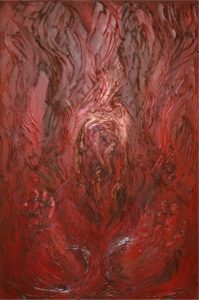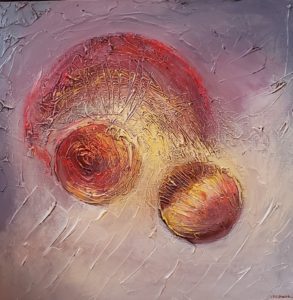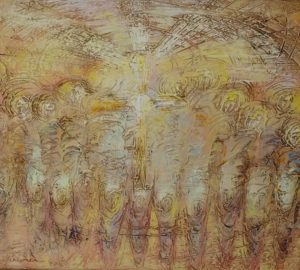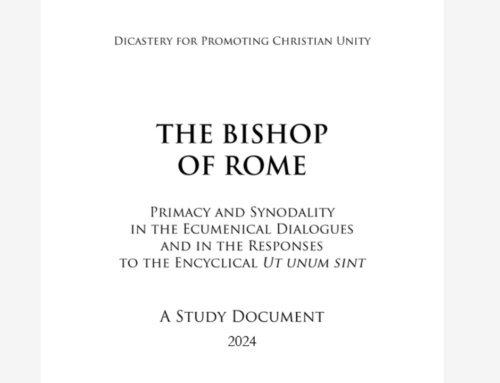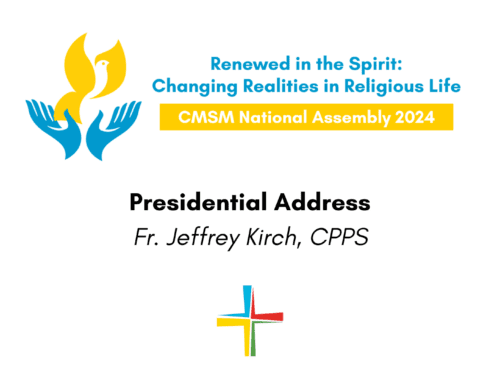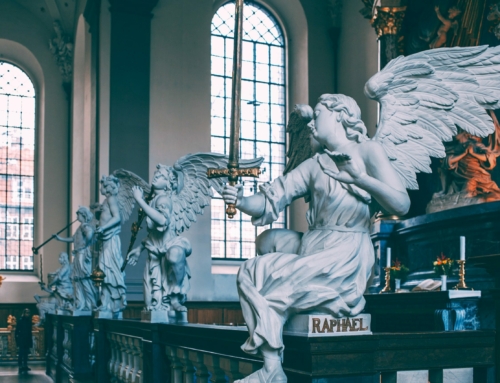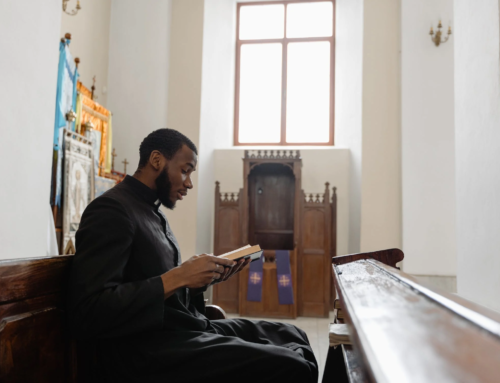The Mosaic exhortation choose life (Deut 30:19) affirms the agency of each person in the evolution of being. We are individually and collectively invited to become protagonists as well as collaborators in charting our futures. A knowing God, a reflective me, and dialogic others, become engaged in the dynamics of becoming. This essay (accompanied by the art of Christian Brother artist Br. Kenneth Chapman, CFC) considers agency as personal and communal engagement in co-creation; envisions such activity in the context of a religious charism; and suggests applications for congregation chapters. Click here to download a copy of this essay.
As our world seeks to emerge from the impact and aftermath of COVID-19, religious around the globe carry forward mission and ministries with a heightened sensitivity to the fragility of sisterhood and brotherhood. The invitation to “co-create” a better future is most attractive. We have learned anew the power and necessity of collaboration. We have seen the impact of group behavior in producing and in relieving suffering. We know firsthand some of the consequences of mistreatment of our common home. We have also seen glimmers of what is possible, appreciating the genuine charity and genius in our midst and within our grasp. We welcome the opportunity to build a better tomorrow.
Agency
In the 1950’s the psychologist Gordon Allport protested that clinicians were tracing human behavior back to early childhood experiences, while women and men were busily living their lives into the future. He focused on intentional action laying a basis for future studies of motivation. In his seminal text Becoming, Allport introduces the term propriate striving to describe the tendency of individuals to direct behavior toward confirming a concept of self—the self as one knows one to be or the self one would prefer to be.
Awareness of self involves a developmental process. Individuals act to fulfill needs and wants, seeking pleasure and avoiding pain. Behaviors one might claim as uniquely belonging to an individual, e.g. to me, are an expression of personal agency. Behaviors can take the form of choices I make to identify, for myself and others, who I am and what I am about. Our choices establish lines of consistency. We refine preferences and set goals. Growing in awareness, we increasingly define ourselves in terms of belonging. Gender, family, friend groups help shape an emerging identity. We embrace others with similar interests in play, social and cultural activities, sports, and entertainment. Our interaction with others opens us to shared values and causes, but also serves to establish a cherished uniqueness.
Salespeople attentive to such striving assure prospective customers this fragrance, this style, this automobile, “is so YOU!”
The terms, agency, becoming, and propriate striving, may also serve to describe the developmental processes of a group. Groups come to perceive the scope and power of their collective action, discern directions of development, and make choices to act in ways that are consistent with a preferred future. The process has been identified as one of co-creation.
Co-creation
Fronteer, a leading agency in designing and implementing facilitation in co-creation, offers the following introduction:
We define co-creation as the collaborative development of new value (concepts, solutions, products, and services) together with experts and/or stakeholders (such as customers, suppliers etc.). Co-creation is a form of collaborative innovation: ideas are shared and improved together, rather than kept to oneself. It is closely connected to – and mentioned alongside – two other buzz-words: ‘open source’ and ‘mass-customization’ (Fronteer, n.d.).
They cite ways in which major companies (Nokia, Alessi, Lego, Apple, eBay, Amazon, Philips) have evolved through group engagement in promoting new products, new profit pools, new ways of thinking, and new energy.
Co-creativity gained ascendency during the past few decades. In an article in Harvard Business Review, Venkat Ramaswamy of the University of Michigan claims to have coined the term in the late 1990’s (Prahalad and Ramaswamy, 2004). From the University of New York, Ajit Kambil et al. (1999) authored Co-creation: A New Source of Value detailing how the internet made it possible for customers to co-create value for businesses. More recent articles in the Stanford Social Innovation Review (2015) report on the application of co-creation concepts and processes in government applications.
Studies in organizational behavior have moved increasingly in directions that serve business and governmental priorities. How to raise the bottom line, address customer satisfaction, test the viability of products, optimize the distribution of goods or services, meet the needs of the many, augment buy-in, maximize client satisfaction, promote employee motivation: in the mix are many elements that may be desirous for a group of religious.
Co-Creation and Religious Life
Religious are more likely to associate the term “co-creation” with themes of evolution in theology and spirituality. Some will emphasize participation in the progress of humanity. Others invite a reexamination of images and concepts from earlier stages of scientific development and call for openness to a “new” cosmology. For instance, Sr. Ilia Delio, OSF (2014) has edited a set of significant essays under the title From Teilhard to Omega. The subtitle reads: Co-creating an Unfinished Universe.
Reintroducing her readers to the Jesuit priest, paleontologist and widely-read author, Sr. Delio identifies the giftedness of Pierre Teilhard di Chardin (1881–1955): “His unique blend of science, Jesuit spirituality, and profound spiritual-mystical insight produced a body of writings that set forth new directions for theology, philosophy, culture, and science itself” (Delio, 2014, p. 2). In The Divine Milieu, Teilhard observes:
I adhere to the creative power of God; I coincide with it; I become not only its instrument but its living extension. And as there is nothing more personal in beings than their will, I merge myself, in a sense, through my heart, with the very heart of God. (Teilhard, 1960, p. 26).
The term “co-creation” does not appear in Teilhard’s publications or letters. It may not be fully consonant with this understanding of being the living extension of the creative power of God. Nevertheless, his writings have become an important source for those articulating a process of co-creating in a religious context.
Teilhard’s spirituality informs and is informed by his scholarship. He studied the earth as a paleontologist. Reportedly, throughout his life, he carried a geologist’s hammer and a naturalist’s magnifying glass, tools of his scientific investigation. He broke through layers to reveal stories of the evolution of the human phenomenon imbedded in the earth. His publications and letters reveal a religious and priest deeply engaged in exploring the evolution and trajectories of consciousness. When and how did consciousness enter the world of material beings? How has consciousness progressed? Where is it headed? Do the directions of progress lead to an eventual point of convergence, an omega point?
Religious life calls for a similar attention to the deepest levels of incarnational engagement, a touching into the life of the individual members and into the realities of their common life. Personal agency and group belonging are defining elements of individual identity. For religious, calls to be one with and in Christ have implications for them both as human beings and as a congregation.
Teilhard finds in his priestly actions both metaphor and realization of his agency, his role in this evolutionary process. A eucharistic theme dominates his concluding presentation in The Divine Milieu:
In fact, from the beginning of the Messianic preparation, up till the Parousia, passing through the historic manifestation of Jesus and the phases of growth of his Church, a single event has been developing in the world: The Incarnation, realized, in each individual, through the Eucharist. All the communions of a life-time are one communion. All the communions of all now living are one communion. All the communions of all present, past, and future, are one communion (pp. 96–97).
The agency of individual religious and their belonging within the corporate identity and charism of a congregation, are central to an engagement in “co-creation.” What one experiences as a calling to religious life, efforts to join the group, the being and doing as a religious, are but the initial steps in a life-long process of articulating the “me” and the “we” of a shared identity.
Chapters
Chapters, particularly General Chapters, offer a vibrant expression of the communal agency of a religious congregation. From the initial announcement, through the gathering of the selected participants, processes are set in place to invite active engagement of all members of the congregation. Every member is urged to participate in the process. Individuals are encouraged to enter private and then communal discernment on the lives they share. From local gatherings to international on-line activity, the goal is to listen to each other, understanding that the Spirit engages all and may be speaking through any of the voices in the room or on the line. All are urged to be agents in authoring a new manifestation of the life of the congregation.
At varying levels communities, clusters, provinces, and eventually delegates to a congregational gathering address here and now questions: Who are we? What are we doing? Who do we want to be? What do we want to be doing? What contribution to Creation is God calling us to embody now? And who is God inviting us to be in the co-creation?
The discernment develops in a context that calls for faithfulness to Jesus Christ and the Gospel, to the Church and her Mission, the Founders of and their charism, and the people of the current age throughout the world (Perfectae Caritatis, October 1965).
The objective is one of identifying elements of life and following trajectories of growth. There may be a call to new action. There may be a celebration of something already in process.
An ultimate expression of human agency may be submission, a pro-active embracing of what necessarily is and what is happening. Jesus in the garden, having invoked the intervention of the Father, acquiesces: “Thy Will be done” (Luke 22:42). Group consensus may require a realigning from previous points of divergence toward a fuller understanding of who we are becoming as individuals and as a congregation. The joy is in the journey.
Guidelines from the Congregation for Institutes of Consecrated Life and Societies of Apostolic Life and the Constitutions of the religious group raise consciousness that a Chapter is an inclusive and ecclesial event. What happens at a chapter impacts the individual members, their apostolates, their co-workers in ministry, and thus the Church. In the closing days of a Chapter, the delegates become increasingly aware of presenting the fruits of their experience. While they labor over modalities of communication, they are reminded that the impact of the Chapter will come from the on-going witness of all effectively engaged in the process.
The Icon of Pentecost
The Acts of the Apostles presents the scene. Disciples who witnessed the passion as well as the post-resurrection appearances of Jesus, are gathered in prayer. Mary, the mother of Jesus is with them – she whose presence stirred the child in the womb of Elizabeth, she who proclaimed, “My soul magnifies the Lord” is simply described as present. The Holy Spirit appears as tongues of fire and those gathered break into missionary discipleship.
A frequent source of inspiration for Br. Kenneth Chapman, CFC, the transformational moment is represented in several of his paintings, each entitled: Pentecost.
It was decades before the accounts of the experience of that first Pentecost were committed to the written word. Then, as now, it is the witness of the participants that launches the energies of Christianity, collaborating in the on-going, co-creative activity of choosing life.
Conclusions
Chapters conclude in celebration of the Spirit and various forms of communication to the members of the congregation. Participants at every level have been encouraged to own and proclaim the emerging story of their congregation. All are invited to fully engage in carrying forward the life-fire that has been discerned.
The participants renew their commitment to the People of God, the men and women of their day, the charism of their founders. They embrace anew the life they share. They use the trajectories of growth, individual and collective, to sketch the outlines of a chosen future, scenarios of possible tomorrows, believing they move with the Spirit, in Christ, as agents, in the creative activity of a loving God.
Appendix: A format for engagement in “co-creation”
Pope Francis proposes “Let us dream.” The following might serve as a process for a group of religious to respond to the invitation.
Premise: A group of religious experiencing ourselves personally and communally called to witness the gospel message of Jesus Christ, trace the movement of the spirit in our personal and collective lives. We seek and gradually note patterns of movement, directions of growth, and a convergence of energies. We seek to articulate a moment of co-creation.
We begin by sharing our individual experiences in a series of conversations involving deep sharing and generative listening. It takes time, perhaps a series of meetings over several months, or an intensive period of discernment over several days.
Themes: What has been the movement? What are the trajectories of what we experience as Spirit directed? With respect to:
Prayer – how has my understanding of God developed? My relationship with Jesus Christ? With my sisters and brothers? What have been some of the milestones on the journey? Where am I now with respect to personal and communal prayer?
Community – what has been my experience of belonging within the Congregation, the Province, the local Community, from first attraction through initial formation and through stages of personal, ministerial, and communal change? How does being a member of the Congregation touch on who I am today? … who we are today?
Ministry—how have I experienced the intersection of my being and doing over my lifetime? …the being and doing of the Congregation over its lifespan?
We examine the trajectories of these personal and communal movements, attending to what we identify as Spirit directed. We make an act of faith in the Trinity and in each other. We ask each other how these trajectories might inform our dreams and resolve.
Bibliography
Allport, G. (1955). Becoming. Yale University Press.
Delio, I. (Ed.). (2014). From Teilhard to Omega – Co-creating an Unfinished Universe. Orbis.
Fronteer. (n.d.) Co-Creation’s 5 Guiding Principles – or what is co-creation made up of? [White paper]. https://fronteer.com/publications/whitepaper-1-what-is-cocreation-made-up-of/.
Kambil, A; Friesen G.B.; and Sundaram A. (1999). Co-creation: A New Source of Value. Outlook, 2. http://kambil.com/wp-content/uploads/PDF/accenture/cocreation2.pdf
Perfectae Caritatis. (1965). Online. https://www.vatican.va/archive/hist_councils/ii_vatican_council/documents/vat-ii_decree_19651028_perfectae-caritatis_en.html.
Prahalad, C.K.; Ramaswamy, V. (2004). “The Future of Competition: Co-Creating Unique Value with Customers.” Harvard Business School Press.
Stanford Social Innovation Review. (2015). Online. https://ssir.org/articles/entry/co_creation_in_government.
Teilhard de Chardin, P. (1960). The Divine Milieu. Harper & Row.
Header image: Pentecost. ©Edmund Rice Christian Brothers Art Foundation, LTD.


